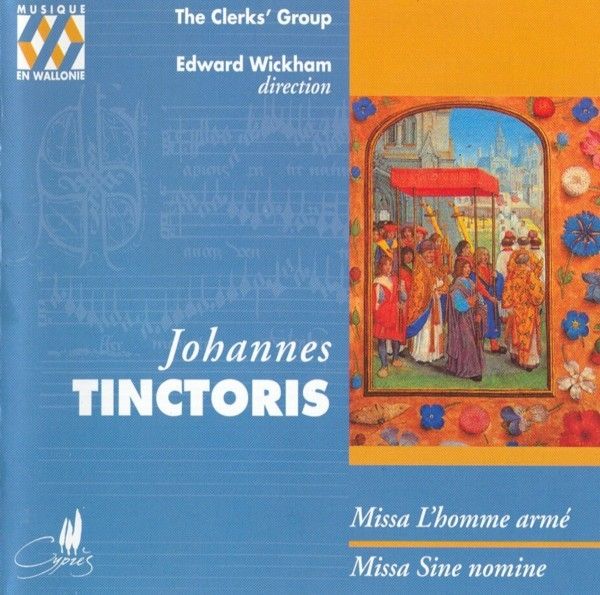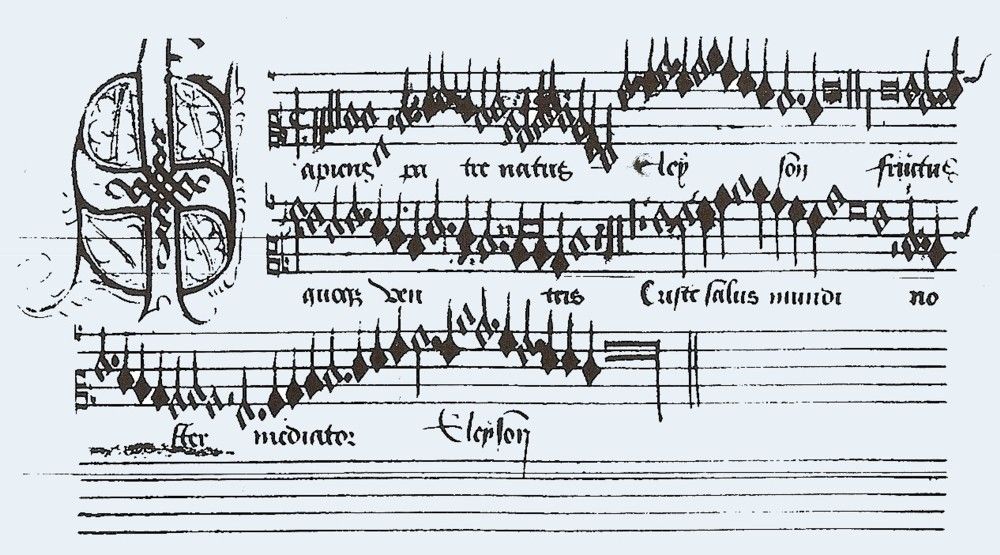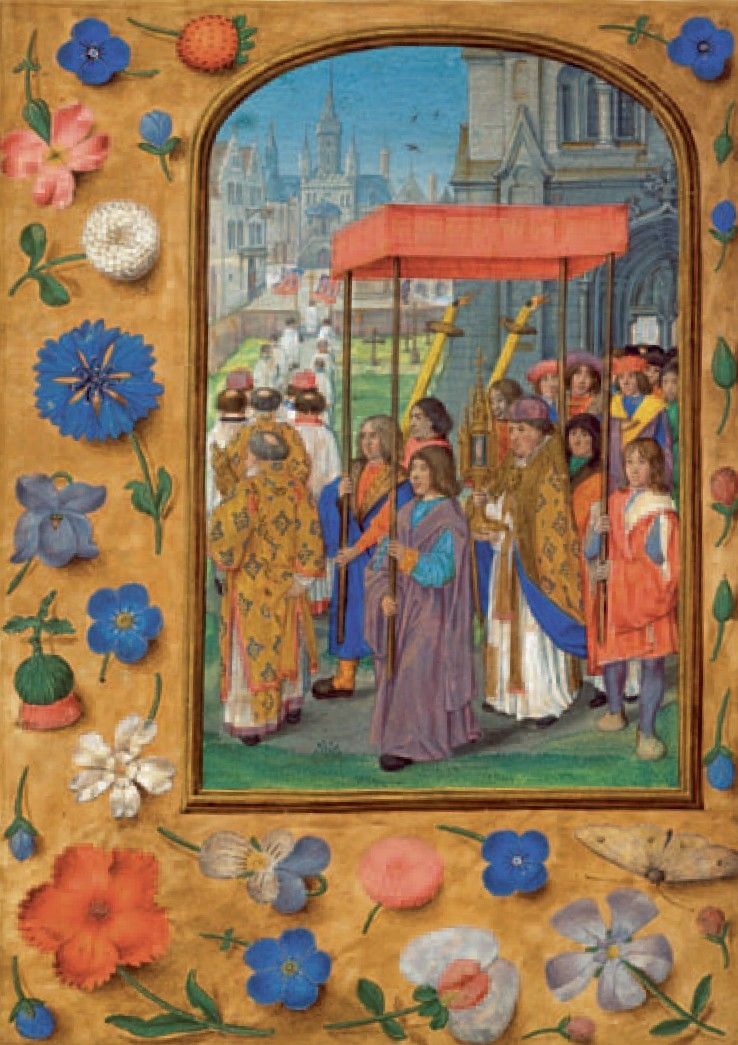Johannes TINCTORIS / The Clerks' Group
Missa L'homme armé · Missa Sine nomine N°1

medieval.org
Cyprès "Musique en Wallonie" CYP 3608
1997
Johannes TINCTORIS
(ca. 1430—ca. 1511)
Missa L'homme
armé
à 4
1. Kyrie [4:23]
2. Gloria [7:40]
3. Credo [7:44]
4. Sanctus [8:39]
5. Agnus Dei [5:43]
Missa Sine nomine
N°1
à 3
6. Kyrie [3:19]
7. Gloria [8:31]
8. Credo [9:08]
9. Sanctus [7:05]
10. Agnus Dei [6:13]
The Clerks' Group
Edward Wickham
Lucy Ballard, William Missin: alto
Tom Raskin, Matthew Vine: ténor
Robert Rice, Jonathan Arnold: bariton
Giles Underwood, Robert Macdonald: basse / bass
Missa L'homme armé
Kyrie
(Vatican, Capp. Sist., Cod. 35.)
Production: Musique en Wallonie
Enregistrement: St. Andrew's Church, West Wratting, 30 avril -3 mai 1997
Ingénieur du son: Manuel Mohino (Musics Numeris)
Directeur artistique: Philippe Vendrix, Jonathan Freeman-Attwood
Montage numérique : Anne Fontigny et Manuel Mohino (Musica
Numeris)
Couverture: Livre d'heures. Gent ca. 1510. Biblioteca Apostolica
Vaticana. Lat. 3769. Fol. 68v.
Graphisme: Edouard Capelle
Réalisé avec le concours du
Ministère de la
Culture de la Communauté française de Belgique (Service
de la Musique et de la Danse),
et de
l'Echevinat de la Culture de la
Ville de Nivelles (Province du Brabant wallon).

Johannes TINCTORIS
(ca 1430- ca 1511)
The name of Johannes Tinctoris is associated primarily with the history
of musical theory. Born in Brabant, he was the author of the first
musical dictionary (Terminorum musicae diffinitorium, 1495) and
a dozen treatises which cover all aspects of musical practice in the
second half of the 15th century, from the rules of counterpoint (Liber
de arte contrapuncti, 1477) to the history of music (De
inventione et usu musicae, 1480) and including a proposal to reform
notation (Liber imperfectionum notarum musicalium, 1475). This
contribution to musical theory would be enough on its own to justify
the importance accorded him. The unfortunate aspect of this reputation
is that his many other activities are all overshadowed by his writings.
Johannes Tinctoris was born in Braine-l'Alleud between 1430 and 1435.
The son of a deputy burgomaster, he appears to have received a thorough
education, both general and musical. No documentary evidence exists of
any activity before he moved to Cambrai Cathedral in 1459-60, but he
may have worked at Saint-Vincent de Soignies or Sainte Gertrude de
Nivelles. In 1460 we find him in the post of "succentor" or deputy
precentor at Orleans Cathedral, where he became choirmaster in 1463. On
1 April of the same year he was appointed "procurator of the Germanic
nation" at Orleans University, an important post which called for a
different theoretical qualification: expertise in jurisprudence. It was
doubtless this double competence as a legal expert and a composer which
motivated Ferdinand of Aragon, King of Naples, to engage him as
"capellanus". It is not possible to determine when Tinctoris left for
Naples, but it may be conjectured that he arrived there around 1472. In
Naples Tinctoris was musical director to the royal household as well as
its legal adviser, and he was also music master to Beatrice, the king's
daughter. His privileged position at court meant that he must have
undertaken several missions from Naples, but, here again, detailed
documentary evidence is lacking. He did not break all his links with
northern Europe; it seems likely that he visited Bruges in 1487. He
also enjoyed a relatively important benefice as canon of the collegiate
church of Sainte Gertrude in Nivelles. No more is heard of him between
1480 and 1511, the probable year of his death.
Not many compositions by Tinctoris survive, but four masses are extant,
one of which is incomplete (three Missa Sine nomine and one Missa
L'homme armé), four motets, and nine secular pieces. To this
fairly meagre sum may be added the musical examples he composed for his
treatises, pieces which often went beyond the minimum requirements for
the purpose.
The Verona manuscript (Bibl. Capitolare, Ms DCCLV) contains one of his
two three-part Sine nomine Masses. It appears under the title Missa
3 vocum secundi toni irregularis cum contratenore extra manum in
diapenthe sub ut. Though it is more than likely that Tinctoris did
not provide this title, it does in fact take up terms used by the
composer in his treatises. These terms deserve some explanation, since
they define what he had in mind: a mass for three voices, with a cantus
notated in the tenor clef, the tenor notated in the bass clef, and a
counter-tenor notated in the G clef, in which G is on the third line,
indicating a bass range a fifth lower than the usual bass clef. The
title makes it clear that the mass is composed in the "secundi toni
irregularis" - the second irregular Tonos. Vague though this definition
is (is he using a normal mode except for the Final, or a transposed
mode?), the mass is clearly in C protus, a transposed Dorian mode,
which is confined to occasional appearances during the 15th century
(only two other examples are known). The special feature of this C
protus mode is that it presupposes two transpositions, to the fourth
above and the fifth below (D to G and G to C), and the exploitation of
a different ambitus. These "irregularities" in the treatment of the
mode do not, however, infringe the rules laid down by Tinctoris in his
treatises: each voice respects its own modal unity but, in addition,
the combination of the first and second modes in their irregular forms
creates a mixture of authentic and plagal which Tinctoris as
theoretician allows. The final part of the title, "with the
counter-tenor extra manum ("out of hand"), a fifth lower", allows the
countertenor part to descend frequently to low C or even low B flat,
thus giving this mass its particular colouring.
The Missa L'homme armé (Vatican, Capp. Sist., Cod. 35)
is not free from peculiarities either. If, in many respects, it fits
well into the famous tradition of masses on a cantus firmus, it twice
has recourse (in the Kyrie and the Sanctus) to tropes. This feature
explains the title sometimes given to this mass, Missa Cunctorum
plasmator summus. In the Kyrie, the nine "proses" of the trope are
distributed equally between the three sections (three in the Kyrie,
three in the Christe, three in the Kyrie 2). The text "Cunctorum
plasmator summus" is not otherwise known, and probably has no
liturgical function. The tropes in the Sanctus reveal themselves to be
a paraphrase of Isaiah VI, 3, while those of the Osanna draw on several
New Testament sources, and those of the Benedictus are original. The
unique character of these tropes lends credence to the supposition that
they were written by Tinctoris himself, according well with the mastery
of Latin he amply demonstrates in his theoretical writngs.
No clues as to dating are available either in the irregularities of the
three-part mass (in which the truncated Credo is also worthy of note)
or in the tropes of the Missa L'homme armé, especially
since these two masses use composing practices which are in no way
unique. Johannes Regis (c.1430 - c.1485) integrated extraneous
texts into the Ordinary of the Mass in his Missa Dum sacrum
mysterium (also a Missa L'homme armé); several
composers of the second half of the 15th century, including Johannes
Ockeghem, exploited low tessituras in their masses, which meant using
unusual clefs. Furthermore, though Tinctoris often mentions the works
of his predecessors and contemporaries in his treatises, he rarely
writes of his own. The Missa l'homme armé has been
variously dated. In 1492, when the Vatican manuscript containing it was
compiled, Tinctoris was probably in Rome for the enthronement of Pope
Alexander VI, a ceremony in which he is thought to have taken part.
Certain musicologists have, moreover, traced links between certain
masses on the cantus firmus "L'Homme armé" and the Order of the
Golden Fleece: Tinctoris worked for an eminent member of this Order -
the King of Naples - and had in fact been asked to translate its
statutes. It is impossible to date the composition of the Missa
L'homme armé with any greater accuracy. It seems definite,
on the other hand, that the Missa Sine nomine was composed for
King Ferdinand, a supposition encouraged by the distich found at the
head of this mass in the Verona manuscript: "Ferdinande sacer inter
divos referende cantica tinctoris suscipe parva tui" ("O Ferdinand,
saintly enough to be counted amongst the gods, accept these little
compositions by Tinctoris").
Tinctoris was an inspired composer who achieved a fine balance between
luxuriant inspiration and a mastery of technique. These two masses
demonstrate this all the more clearly by presenting different
approaches to polyphonic writing. The four-part texture, like that of
the motet, and the three-part texture, more like that of song, oblige
the composer to treat his musical material in two different ways,
confirming that the three-part texture cannot be envisaged simply as a
reduction of a four-part one. They confirm that Johannes Tinctoris was
a man of many talents: they stimulate the mind while also charming the
ear.
Philippe Vendrix
Translated by Celia Skrine



